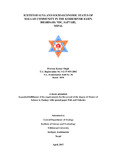Please use this identifier to cite or link to this item:
https://elibrary.tucl.edu.np/handle/123456789/1406| Title: | Ichthyofauna and Socio-Economic Status Of Mallah Community in the Koshi River Basin, Bhardaha Vdc, Saptari, Nepal |
| Authors: | Singh, Praveen Kumar |
| Keywords: | socio- economic status;Society;FIsh;Fauna |
| Issue Date: | Apr-2017 |
| Publisher: | Central Department of Zoology Institute of Science and Technology Tribhuvan University Kirtipur, Kathmandu Nepal |
| Abstract: | The present study entitled" Ichthyofauna and socio-economic status of Mallah community in the Koshi River Basin, Bhardaha VDC, Saptari, Nepal "deals with the distribution and frequency occurrence of fishes in the Koshi River Basin. The study also includes the socio-economic status of the Mallah of the Koshi River Basin. In the present study the field work was carried out for two months i.e. month of February and month of June 2016. Altogether 12 species of fish fauna under 10 genera, 7 families and 4 orders were recorded. The fish sampling was performed by local fishermen with gear like cast nets, gill nets, Tapi. The most abundant family within catch was Cyprinidae. Labeo dero and Aspidoperia morar were the most abundant fishes in all the study sites during the month of February and June respectively. The dominant species of fish recorded was Labeo dero with highest frequency occurrence of 25.24% in the month of February and Aspidoperia morar with highest frequency occurrence 36.29% in the month of June. The most common species were cyprinids comprising altogether 6 species. The highest estimated catch was recorded in June and lowest in February. The fishermen belong to a number of ethnic groups such as Godhi, Mallah, Mukhiya, Bahardhar. There are about 85 household fishermen in Bhardaha VDC-1 to 6, Saptari of which 65 household are solely dependent on the fishing while the rest of the families have source of income from government job, agriculture and abroad employment. The socio-economic status of the fishermen communities is the lowest in the society. On the basis of age distribution data shows that the economically most active group represents only 17.83% at the age of 15-25 years and they support the rest of the family members by fishing. Similarly, the age group illustrates 35.03% at the age of 26-35 years considered as dependent group. But the age group above 35 reveals 47.13% regarded as less active group whose economic status was low as comparisons to the most active and dependent group Above 3,00,000 represents High income of the respondents income per annum. From the data it is found that 10.88% of people were low income (above NRS 3,00,000) and 60.89% people with high income ( NRS 1,00,000-3,00,000). About 4.81 % of the respondents were illiterate even though most of them were found to pass 4 or 6 class. Among literate only 1.60 % passed SLC and only 1.20% attended HSEB. The urgent attention is to be needed to improve the socio-economic status of the fishermen communities is the lowest in the society. |
| URI: | http://elibrary.tucl.edu.np/handle/123456789/1406 |
| Appears in Collections: | Zoology |
Items in DSpace are protected by copyright, with all rights reserved, unless otherwise indicated.

